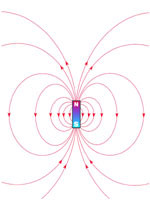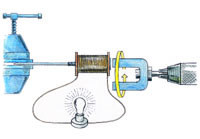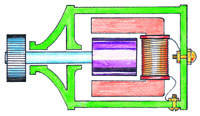This content is associated with The Open University's Science qualifications.
Do it yourself
A generator is simply a device that converts mechanical energy (itself derived from coal, oil, natural gas, wind, water, nuclear reactions or other sources) into electrical energy. Here, we describe how to use readily available materials to make a simple generator. Although it will only be powerful enough to light a small torch bulb, it works on the same basic principles as the power station generators that supply domestic electricity.
How a generator works
When an electric current flows through a wire, it generates a three-dimensional magnetic force field around the wire, similar to that surrounding a bar magnet. Magnets are also surrounded by a similar three-dimensional field. This can be ‘seen’ in two dimensions if iron filings are sprinkled on a sheet of paper placed over the magnet. The filings align themselves along the lines of magnetic force surrounding the magnet.
 Two-dimensional representation of the magnetic field around a bar magnet. The arrows indicate the direction of the lines of magnetic force. The N (north) and S (south) indicate the poles of the magnet, where the lines of force are focused. The north pole of the magnet will repel the north pole of a compass or another bar magnet, while its south pole will attract the north pole of a compass or another bar magnet.
Two-dimensional representation of the magnetic field around a bar magnet. The arrows indicate the direction of the lines of magnetic force. The N (north) and S (south) indicate the poles of the magnet, where the lines of force are focused. The north pole of the magnet will repel the north pole of a compass or another bar magnet, while its south pole will attract the north pole of a compass or another bar magnet.
The simplest generator consists of just a coil of wire and a bar magnet. When you push the magnet through the middle of the coil, an electric current is produced in the wire. The current flows in one direction as the magnet is pushed in, and in the other direction as the magnet is removed. In other words, an alternating current is produced. If you hold the magnet absolutely still inside the coil, no current is generated at all. Another way of producing the current would be for the magnet to be rotated inside the coil, or for the coil to be rotated round the magnet.
This method of generating electricity, called induction, was discovered by Michael Faraday in 1831. He found that the stronger the magnets were, the more turns of wire in the coil, and the quicker the motion of the magnet or coil, the greater the voltage produced. Faraday also observed that it was more efficient if the coil was wound around a metal core, as this helped to concentrate the magnetic field.
Voltage and current
What do the electrical terms voltage (measured in volts) and current (measured in amperes, often shortened to amps) mean? Imagine the electric current flowing in a conducting wire to be like cars travelling along a motorway. The motorway is the wire and the voltage the speed at which the cars move. The current corresponds to the number of cars passing a given point each second.
When a current flows through a wire, electrical energy is converted into other forms of energy, like heat in a heating element, light from the filament of a bulb, or sound from a loudspeaker. The electric current could also be made to produce mechanical energy, which is what happens in an electric motor. A motor is therefore just a generator operating in reverse.
Making your own generator
What you'll need
- cardboard
- 15cm long iron nail with a 6mm diameter and a large head
- 8–10cm long bolt with a 6mm diameter, and nut
- 25m enamelled copper wire (30 swg or approx. 0.3mm diameter)*
- E825 eclipse button magnet (with a fixing hole)*
- 6V, 0.06A torch bulb and bulb holder*
- a roll of insulating tape*
- a hand drill
* Obtainable from DIY stores, or electronic shops.

a simple generator
What to do
Your generator will consist of a coil held close to a spinning magnet.
- Cut out two cardboard discs roughly 3cm in diameter, and make a 4–5mm hole in the centre of each. Insert the nail in the hole and push one disc up to its head. Cover the next 2–3cm of the nail’s surface with a couple of layers of insulating tape.
- Slide on the other disc until it butts up against the tape, and then wind more tape on the other side of it to fix it in position so that the cardboard discs are no more than 2–3cm apart. Unwind 30cm or so of wire from the reel to form a lead from the coil, and start winding the remaining wire around the insulating tape between the two cardboard discs. To keep track, it may help to make a tick mark on a piece of paper after every 100 turns. The number of turns is not critical, but the more the better; 1 500 should do.
- Having covered the nail with a single layer of turns, continue building up layers one on top of the other. You don’t have to do a particularly neat job.
- After about 1 500 turns, leave about 30cm of wire free at the other end and then cover the windings with insulating tape. Remove a cm or so of the insulation from the two end wires by scraping off the enamel, and connect them to the bulb holder. Fit the bulb into the holder.
- Pass the bolt through the hole drilled into the base of the magnet, and fasten it by tightening the nut. Fix the bolt into the chuck of a hand drill. Next, fix the sharp end of the nail in a vice (or between two heavy books) so that it’s horizontal. Bring the magnet to within about 1mm of the nail head, which should be slightly off-centre from the middle of the spinning magnet. Make sure the gap between the magnet and the nail head is as small as possible, but not so close that they touch. A tip here is to rest the hand holding the fixed part of the drill on the table-top so that it’s as steady as possible.
Turn the drill handle as fast as you can and the bulb should light up. Generating electricity really is as simple as this!
Generators in bikes and cars
Cars need a direct-current supply to operate the ignition, lights, windscreen wipers, etc. This is generated by an alternator which is mechanically coupled to the engine. A device called a rectifier is used to convert the alternating current output to direct current. A regulator also has to be fitted to control the current, so that the alternator’s output voltage continues to match the voltage of the vehicle’s battery as the engine speed changes.
A dynamo on a bicycle, that produces electricity as you cycle, is another example of a generator. Its basic design is just the same as the home-made generator described above.

a bicycle dynamo



Rate and Review
Rate this article
Review this article
Log into OpenLearn to leave reviews and join in the conversation.
Article reviews